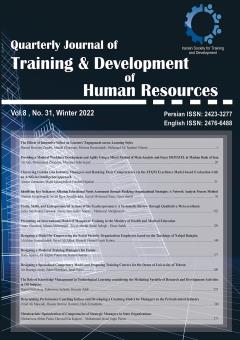Determining Performance Coaching Indices and Developing a Coaching Model for Managers in the Petrochemical Industry
Subject Areas :Omid Ali Mashodi 1 * , Hassan Darzian Rostami 2 , Hadi Zeraatpisheh 3
1 - Associate Professor, Department of Communication, Faculty of Culture and Communication, Soura University, Tehran, Iran
2 - Assistant Professor, Department of Communication and Media Management, Faculty of Social Sciences, Communication and Media, Islamic Azad University, Central Tehran Branch, Iran
3 - دانشجوی دکتری مديريت ارتباطات، گروه علوم ارتباطات و رسانه، دانشکده علوم اجتماعی، ارتباطات و رسانه، دانشگاه آزاد اسلامی، واحد تهران مرکز، ايران .
Keywords: Coaching, Performance Coaching, Coaching Indices, Coaching Dimensions, Performance.,
Abstract :
The present study aimed to develop a model for performance coaching indices for public relations managers of petrochemical companies in the South Pars region. This applied study used exploratory content analysis to form categories including dimensions, components, and behavioral indices. A mixed-methods approach was used for data collection and analysis. In the qualitative phase, data were collected via interviews with experts in the field of coaching. The data collected in the qualitative phase were analyzed using content analysis of texts, interviews, and questionnaires with a Delphi approach. In the quantitative phase, data were collected via surveys with the network pairwise comparison questionnaire and the standard ACHIEVE performance measurement questionnaire. Twenty experts were recruited for the qualitative phase and 160 public relations managers for the quantitative phase. The results of the research showed that experts agreed on three individual, social, and organizational dimensions by consensus. Experts agreed on the indices obtained from the review of literature and interviews, which included eight individual indices, six social indices, and five organizational indices. Organizational dimension had the highest effect on performance management with a path coefficient of 4.6, followed by the individual dimension with a path coefficient of 2.55, and the social dimension with a path coefficient of 2.46. Based on path coefficient analysis in structural equations, the priority of indices (path coefficient) in the individual dimension was as follows: behavior and character (9.36), media literacy (2.33), cognitive intelligence and empowerment (7.25), personality (5.19), and accountability (8.9). The priority of indices for the social dimension was as follows: communication skills (4.28), status and position (3.26), participation (2.24), dynamism (5.19), altruism (3.17), and team planning (1.14). The obtained indices were tested for their relationship with performance components based on the ACHIEVE model. The test results showed that the path coefficients of individual, social and organizational dimensions on performance management were 0.190, 0.267, and 0.397, respectively. This means that the factors have a positive and significant effect on performance management and the developed model is approved.

